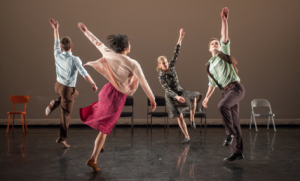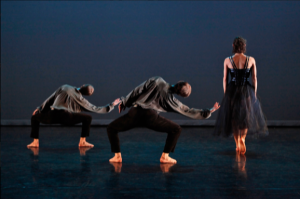The Genius of Ambiguity: Mark Morris at La Jolla Music Society’s Summerfest
The performance by the Mark Morris Dance Group at Summerfest last week was like a loaf of artisan rye bread—dense, complex, chewy. The evening at the Conrad Prebys Performing Arts Center was so packed with dance, music, and ideas, I would have like multiple viewings: once to focus on Morris’s choreography and brilliant movers, once for the world-renowned Summerfest musicians, and a third time to lose myself in the thrilling voice of countertenor John Holiday.

“The Office”
The program of five dances, presented by the La Jolla Music Society, offered a 35-year span of Morris’s work, beginning with two works from the early years of his Brooklyn-based company, founded in 1980. And the evening culminated with a world premiere, “Arrows. Eros.”
A lighthearted look at youthful love, “Arrows. Eros.” is set to two Handel songs. Three pairs of dancers, costumed (by Elizabeth Kurtzman) in clear red or ice-blue, are absorbed in each other … until they notice the other options and proceed to fluidly couple and uncouple. Long-limbed, elegant Laurel Lynch and tiny powerhouse Lauren Grant, who is so filled with light she makes me think of Tinkerbell, are a particularly striking pair.
The movements have a lilting quality, with occasional hints of courtly dance. In the song “Tanti strali,” HWV 197, the libretto (by Ortensio Mauro) speaks of Cupid’s arrows, and the famously musical Morris has the dancers dodge imaginary arrows, catch them, or get struck in the heart. (I had the chance to attempt some of this sequence in a public class Thursday afternoon. What an ideal way to connect people to dance, so that they feel it in their bodies.)
The same kind of flirtatious play occurs in the vocals, performed by Holiday and soprano Jennifer Zetlan with call-and-response phrases and harmonies so luscious they sometimes overshadowed the dance. (My colleague Ken Herman writes with more detail and expertise about the music in his review of this program.)

“Prelude and Prelude”
The pieces in the first half of the program were from the 1980s and 90s—and hurray for showing these works in chronological order.
In “Prelude and Prelude” (1984), nine dancers, wearing black maillots, hold fans—sometimes between their teeth—and fan out from a vertical line doing a series of hand gestures (another bit taught in the public class). But one or another breaks away, echoing the order and disorder in Cowell’s Set of Two for Violin and Harpsichord, the calm regularity of the harpsichord (played by Colin Fowler) challenged by the rebellious discord of the violin (Augustin Hadelich).
Morris is noted for irony as well as musicality, and in “One Charming Night” (1985), he uses songs by Purcell for a vampire tale. Mica Bernas is the shy yet eager innocent—sitting on and jumping up from a bench in a fever of expectation—as Holiday’s countertenor enchants. Dallas McMurray enters as the balletically graceful predator, swooping with his arms spread like a kid playing airplane. McMurray’s technique is so refined, it made me curious to see how this piece looked originally, when Morris danced the vampire role.

Mark Morris as the vampire in “One Charming Night”
Both camp and heartfelt, “One Charming Night” plays with the text—“Night, and I improve the taste”—but also mourns Bernas’s fall from innocence, and it becomes sheer beauty as Holiday’s voice soars in the final hallelujahs.
As a teen, Morris did Balkan dance, and “The Office” (1994), to Dvorak’s Bagatelles for Two Violins, Cello, and Harmonium, Op. 47, plays delightfully with folk-dance forms: hand-holding lines, nimble footwork and changes in direction, fiery circle dances. Six dancers, dressed as if for clerical jobs (vests and sweaters, not jackets) sit as if in a reception area; gradually, they get up to dance. A man in a suit appears; there’s a sense of dread, and a woman leaves with him. The rest are briefly subdued but resume their dance. The suit returns, taking a man this time. The rest dance. Another one is taken. And another. The final two dance with increasing urgency.
One of the things I loved about this piece (my personal favorite) was the discussion during the intermission about what it meant. Job interviews? Corporate layoffs? And were the people who remained dancing with more verve because they were happy to be spared, or were they being pressed to do the work of everyone who’d left? Or maybe this piece wasn’t about work at all, but a metaphor for death?

“The Muir”
“The Muir” (2010), in the second part of the program (before “Arrows. Eros.”), provoked similar questions about its intent. The lyrics, from English-language folk songs, seem to invite irony: “… pretty Sally, she’s the darling of my heart, and she lives in our alley.” And, even when the text speaks of true love, Morris often has one of the six dancers switch among several suitors. Yet the music is glorious—Beethoven’s “An Arrangement of Folk Songs,” sung by Zetlan, tenor Robin Tritshler, and baritone David Pershall. And the dance has moments of loveliness, for instance, in the last section when the men go into deep plies and lean to the side with gracefully curving arms.
Ambiguity made “The Office” even richer; on the other hand, it kept me from engaging with “The Muir.” No matter. Whether or not the arrow strikes dead-on, ambiguity is part of Morris’s genius.

Award-winning dance journalist Janice Steinberg has published more than 400 articles in the San Diego Union-Tribune, Dance Magazine, the Los Angeles Times, and elsewhere. She was a 2004 New York Times-National Endowment for the Arts fellow at the Institute for Dance Criticism and has taught dance criticism at San Diego State University. She is also a novelist, author of The Tin Horse (Random House, 2013). For why she’s passionate about dance, see this article on her web site, The Tin Horse

Janice, I completely agree with you that this evening of dance and music integrated with such sophistication and performed at such a high level begged to be experienced multiple times! Thanks for giving your insights about each dance and how they fit on the Mark Morris artistic timeline. Dare we hope that this dance component could become a SummerFest tradition?